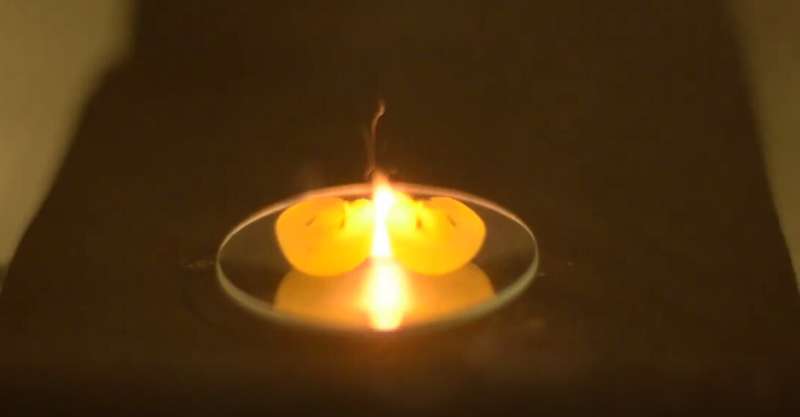Proceedings of the National Academy of Sciences (2019). DOI: 10.1073/pnas.1818350116
A trio of researchers with McMaster, Concordia and Trent Universities has solved the mystery of why pairs of grapes ignite into fireballs when cooked together in a microwave oven. In their paper published in Proceedings of the National Academy of Sciences, Hamza Khattak, Pablo Bianucci and Aaron Slepkov claim that the fireball is not the result of heat from the outside of the grapes making its way in, but instead comes about due to hotspots that form in both grapes.
Back in 2011, impressive videos of grapes igniting in microwaves went viral on YouTube. All a person had to do was cut a grape in half, leaving the two halves connected by a bit of skin at the bottom, and heat them in a microwave oven—within seconds, a tiny fireball would appear between them. Making things even more exciting was that nobody could explain it. Since that time, many armchair scientists have presented possible explanations—one of the more popular was the suggestion that the grapes somehow form an antenna directing the microwaves across the skin bridge. In this new effort, the physicists in Canada ran multiple tests on the grapes and other similar objects to learn the true reason for the formation of the fireball.
The tests consisted mostly of using thermal imaging cameras to capture the action as the grapes were heated and running simulations. They also tested other similarly sized fruit and plastic balls filled with water.
The researchers found that the formation of the fireball was the result of a simple process. As the microwaves enter the grapes, hot spots form in both pieces at the points where they are closest to one another due to a bond between them. As the hot spots grow hotter, surrounding electrolytes become supercharged, resulting in the formation of a burst of plasma in the form of a small fireball.
The researchers note that the same effect could be produced using similarly sized fruit or water-filled balls. They also found that it is not necessary to maintain any sort of physical connection between the two pieces—all that is required is that they be no more than three millimeters apart.
Proceedings of the National Academy of Sciences (2019). DOI: 10.1073/pnas.1818350116
Proceedings of the National Academy of Sciences (2019). DOI: 10.1073/pnas.1818350116
More information: Linking plasma formation in grapes to microwave resonances of aqueous dimers, Proceedings of the National Academy of Sciences (2019). DOI: 10.1073/pnas.1818350116
Journal information: Proceedings of the National Academy of Sciences
© 2019 Science X Network























